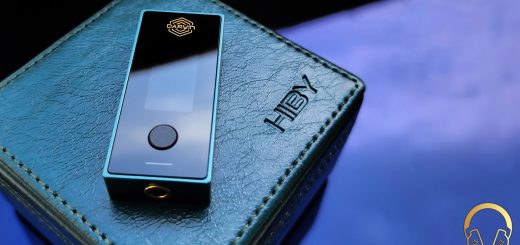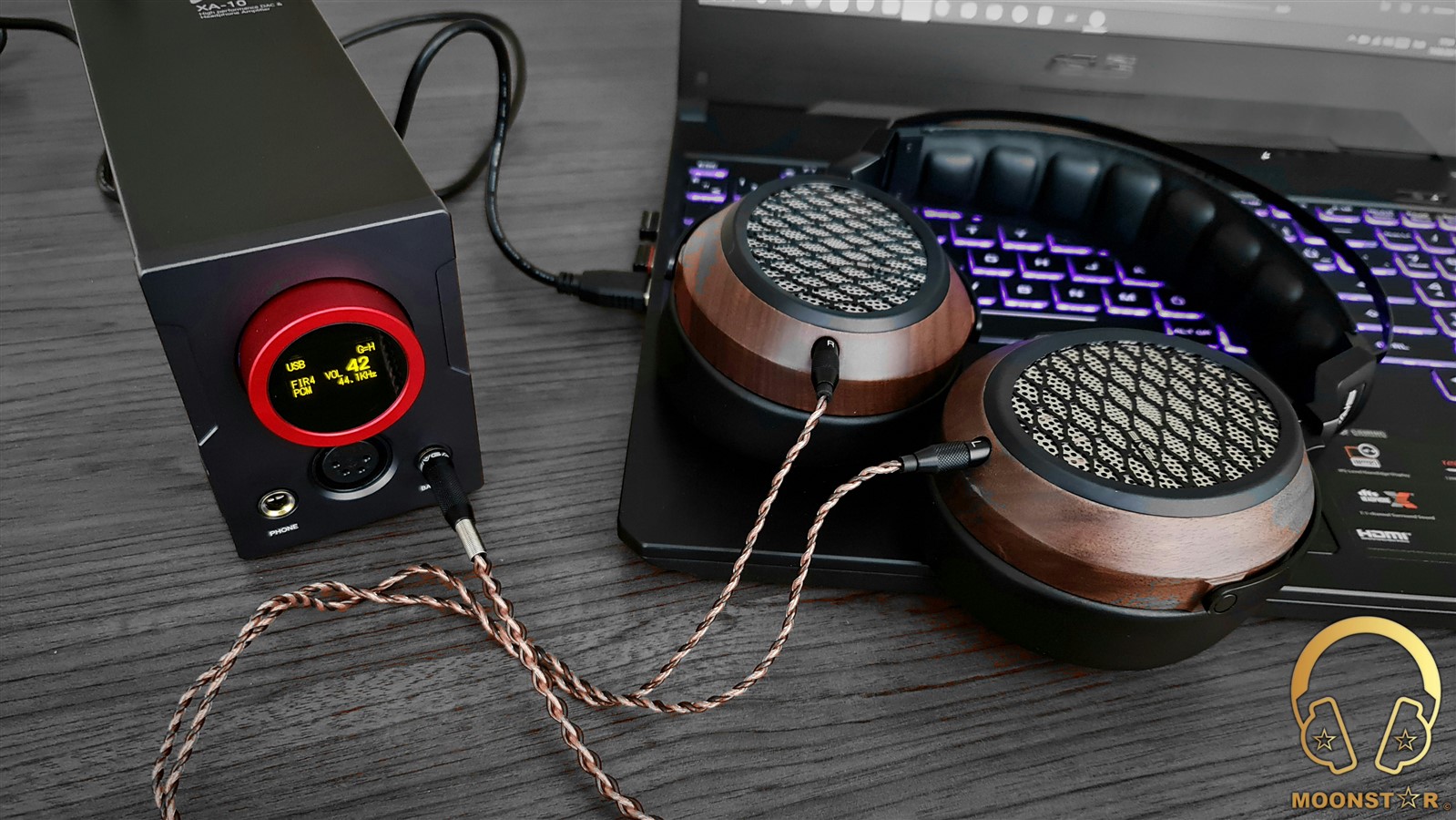FiiO K7 DAC & Headphone Amplifier Review
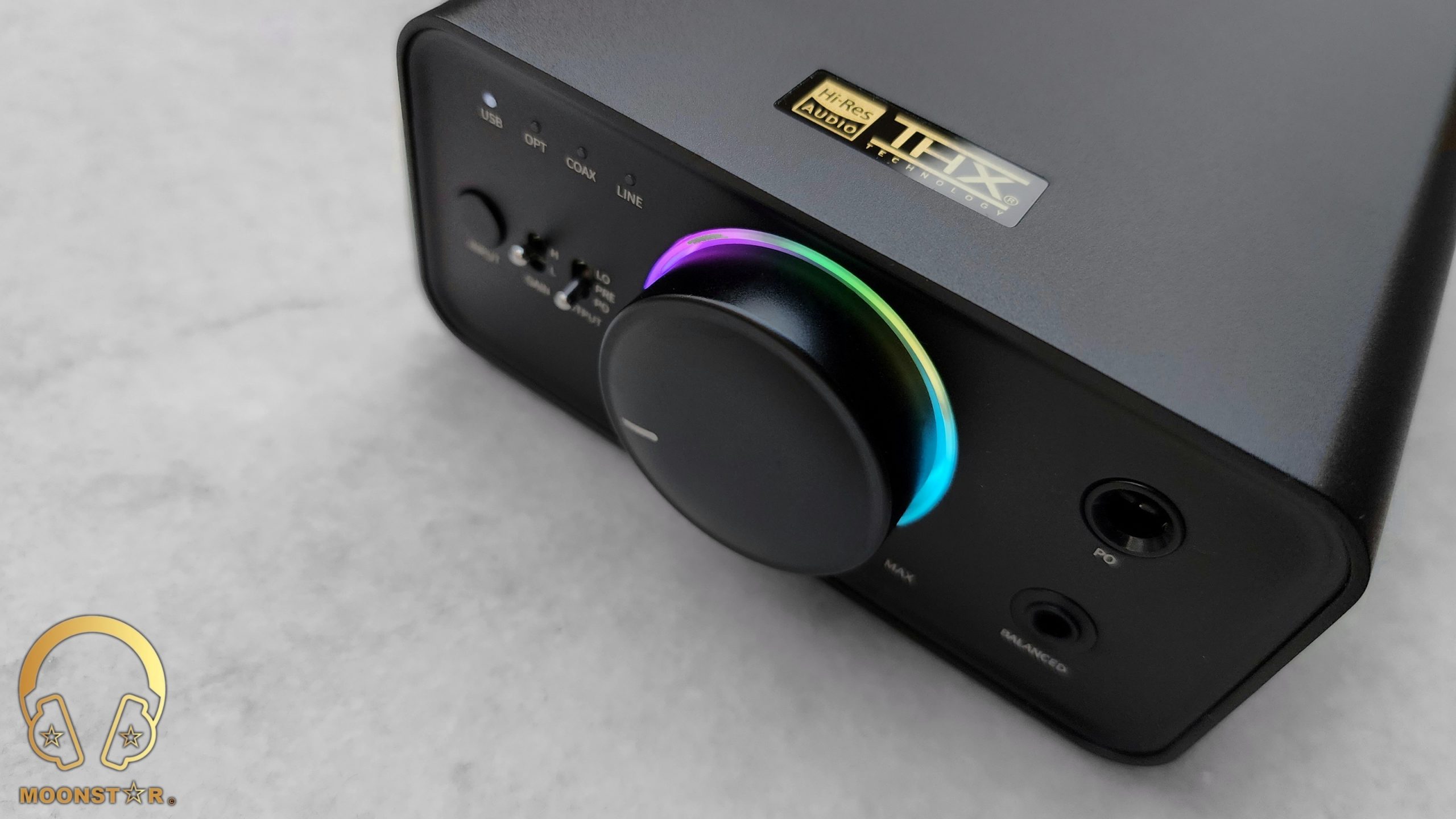
FiiO K7 DAC & Headphone Amplifier Review
Introduction:
The K7 is FiiO’s latest true balanced desktop DAC & Headphone Amplifier that comes with some interesting specs such like a Dual AK4493SEQ DAC Chip setup, 2x THX AAA 788+ amplifiers, XMOS USB receiver and NJU72315+OP Volume chips. Moreover, the device features USB, Optical, Coaxial, RCA inputs and both 6.35mm Single-Ended + 4.4mm Balanced analog output interfaces.

Disclaimer:
I would like to thank FiiO for providing me the K7 DAC & Headphone Amplifier as review sample. I am not affiliated with FiiO beyond this review and these words reflect my true and unaltered, opinions about the product.
Price & Availability:
The FiiO K7 is a quite reasonable priced Headphone DAC/Amplifier that is actually available for 199.99 US$. More information’s can be found under the link below;
Package & Accessories:
The FiiO K7 came inside a square shaped black box that was wrapped with a cardboard sleeve that has a fancy design that sport the illustration and some product related brandings with an iridescent finish on its surface.

The box of the K7 contains the following items:
- 1 x FiiO K7 Desktop Headphone DAC/Amplifier
- 1 x USB-A to USB-B cable
- 1 x Power Cable
- 1 x Power Adapter
- 1 x User Manual & Warranty card
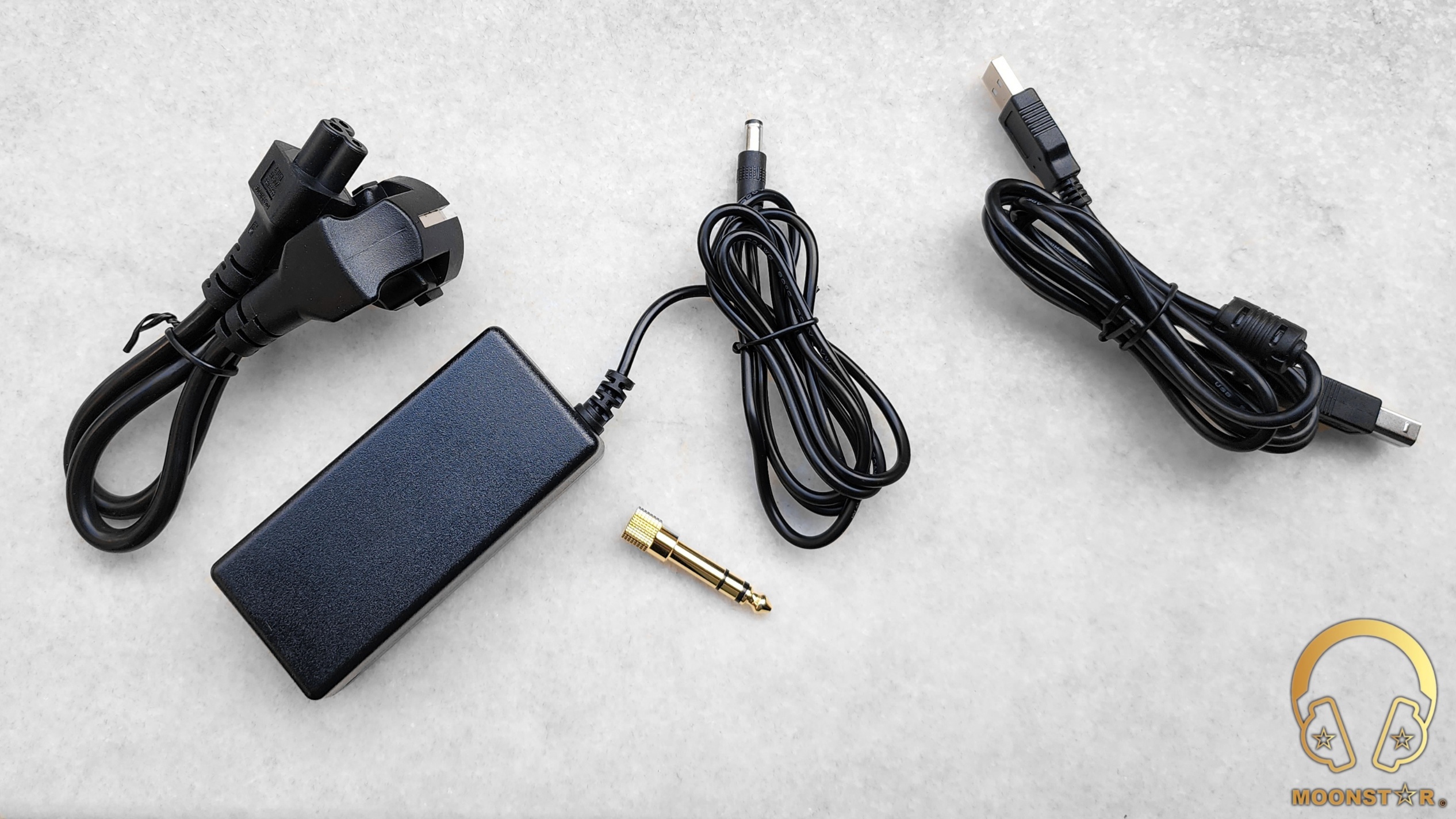
Design & Build Quality:
The FiiO K7 is the company’s latest true balanced desktop type DAC & Headphone Amplifier that features a pretty robust CNC machined Aluminum body with a black finish. The K7 is equipped with multiple input, output and control interfaces that are located on the front and rear side of the device. The device has dimensions of about 120 x 168 x 55mm and weights approx 610grams.
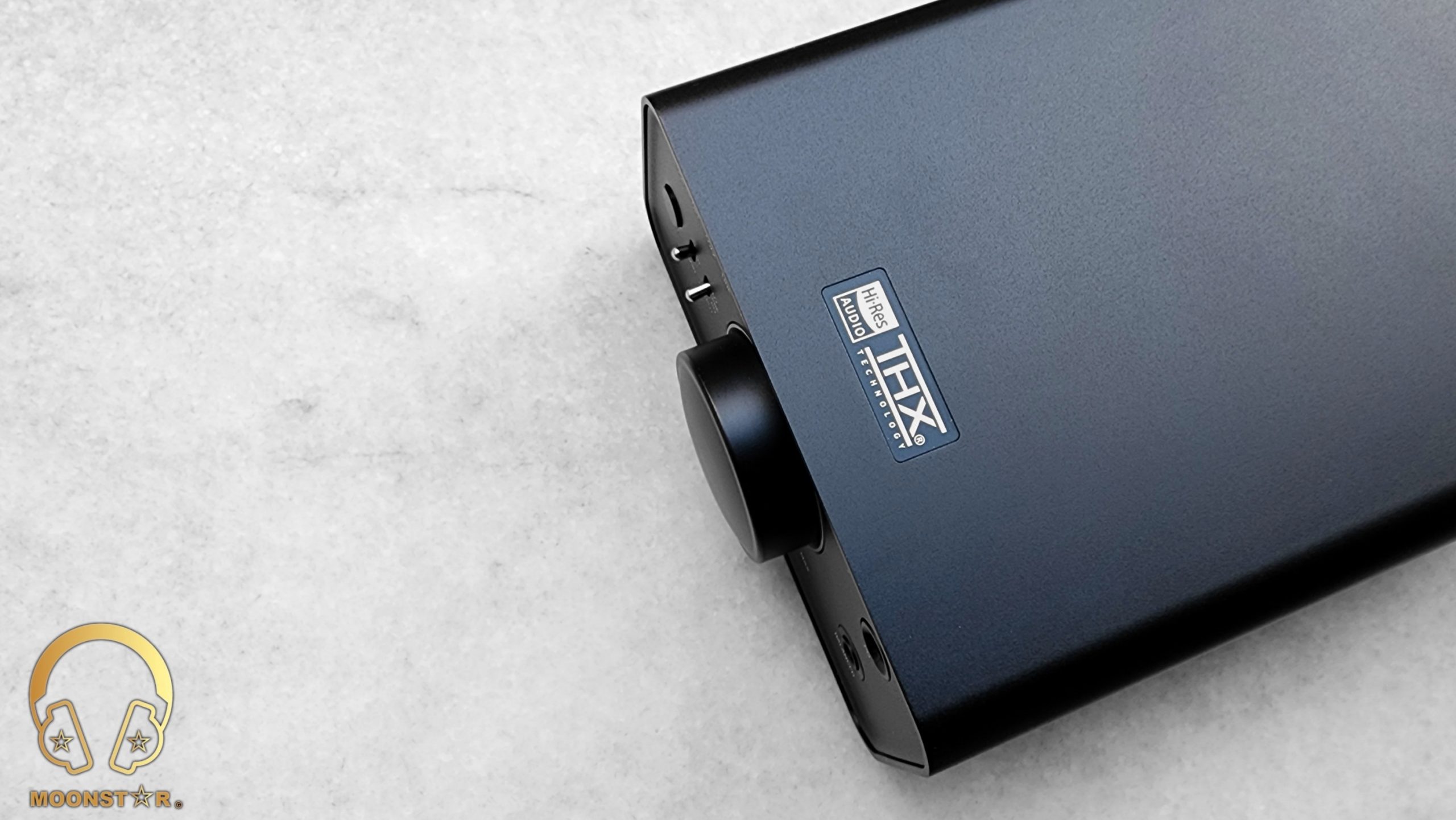
On the top of the device are the FiiO brand logo and a label with the Hi-Res Audio & THX Technology branding.
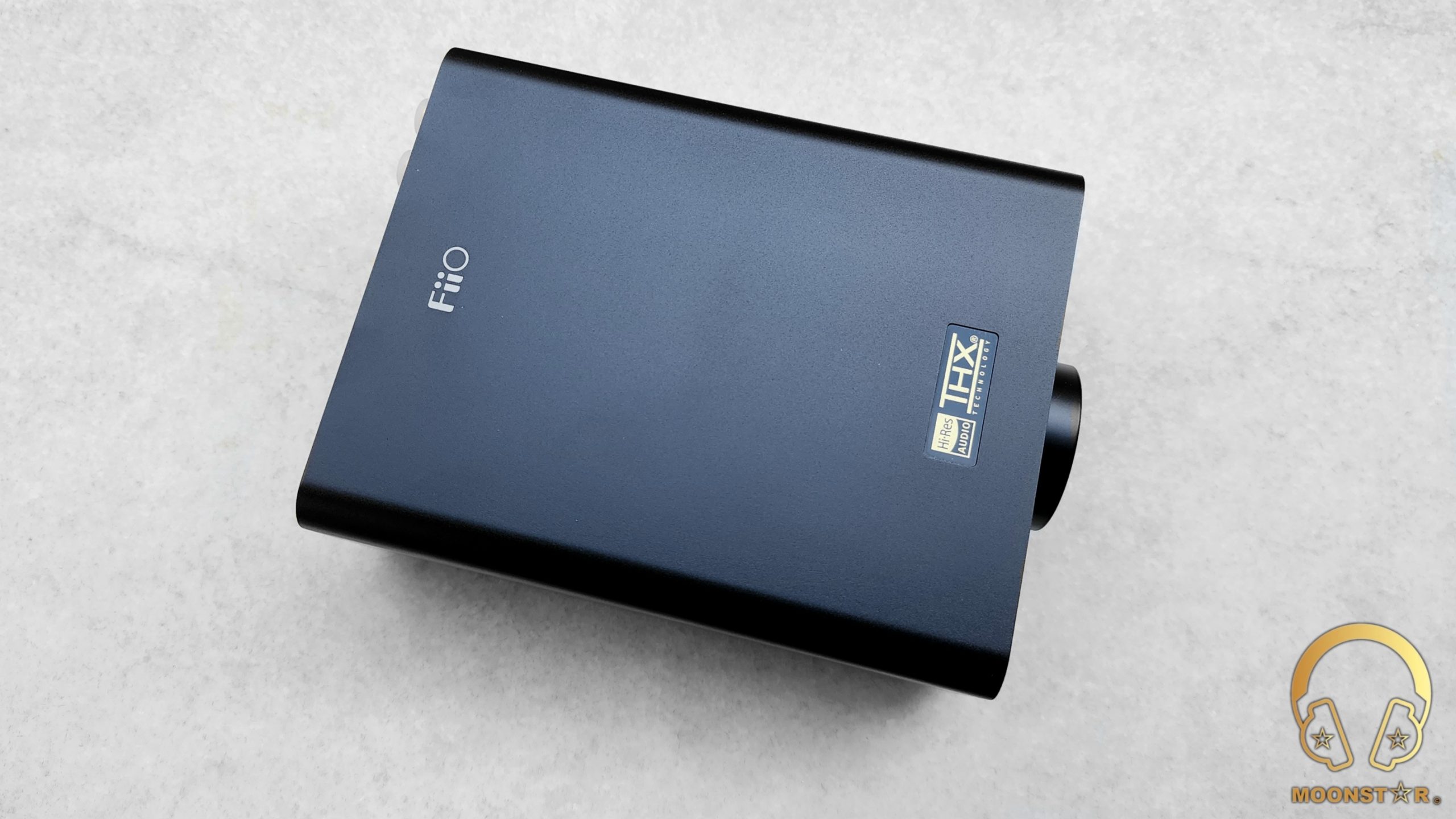
The front panel of the K7 is equipped with the analog outputs and multiple control tools such like buttons, potentiometers and switches.
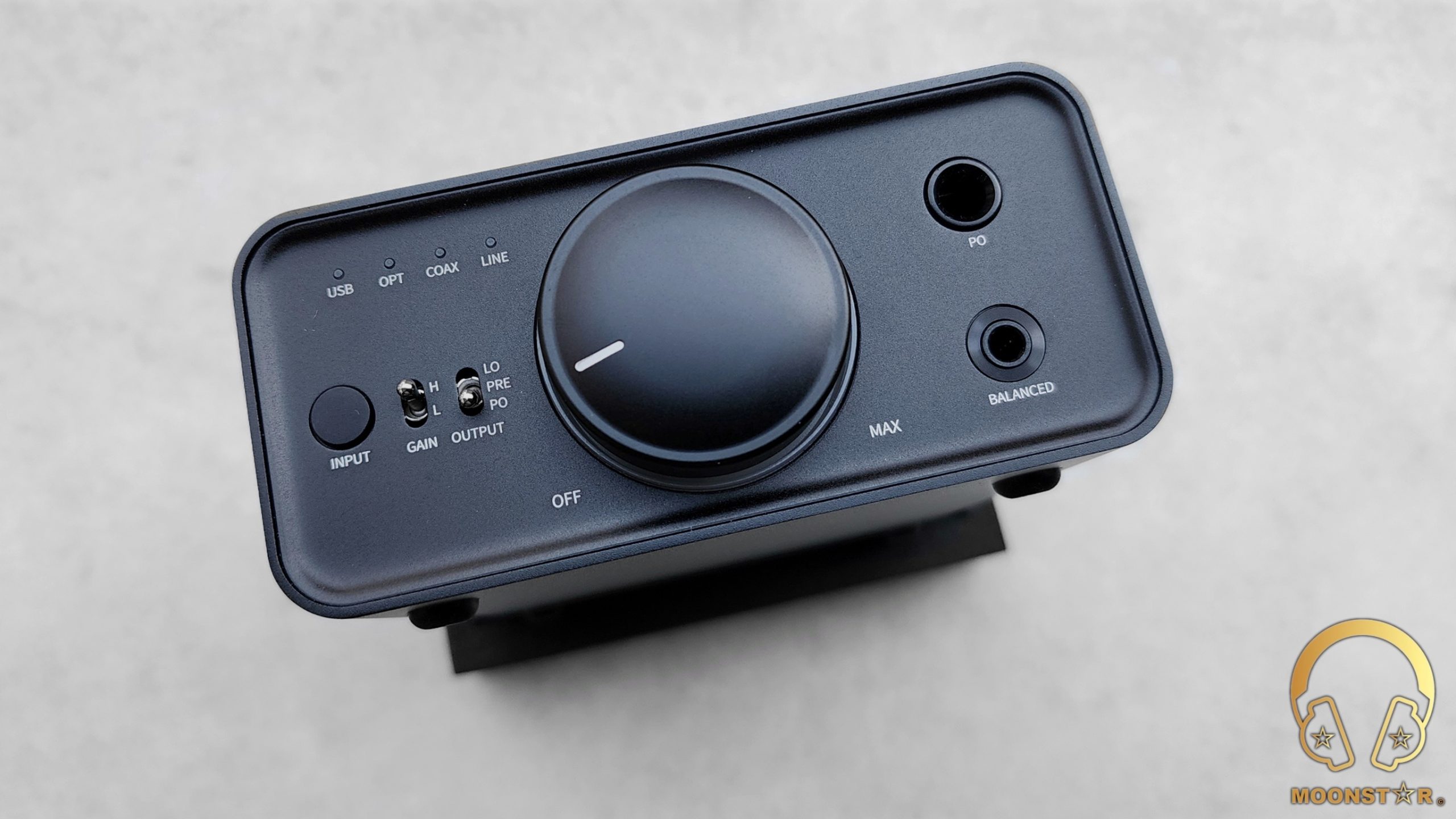
The right side of the front panel features the 6.35mm Single Ended and 4.4mm Balanced headphone outputs.
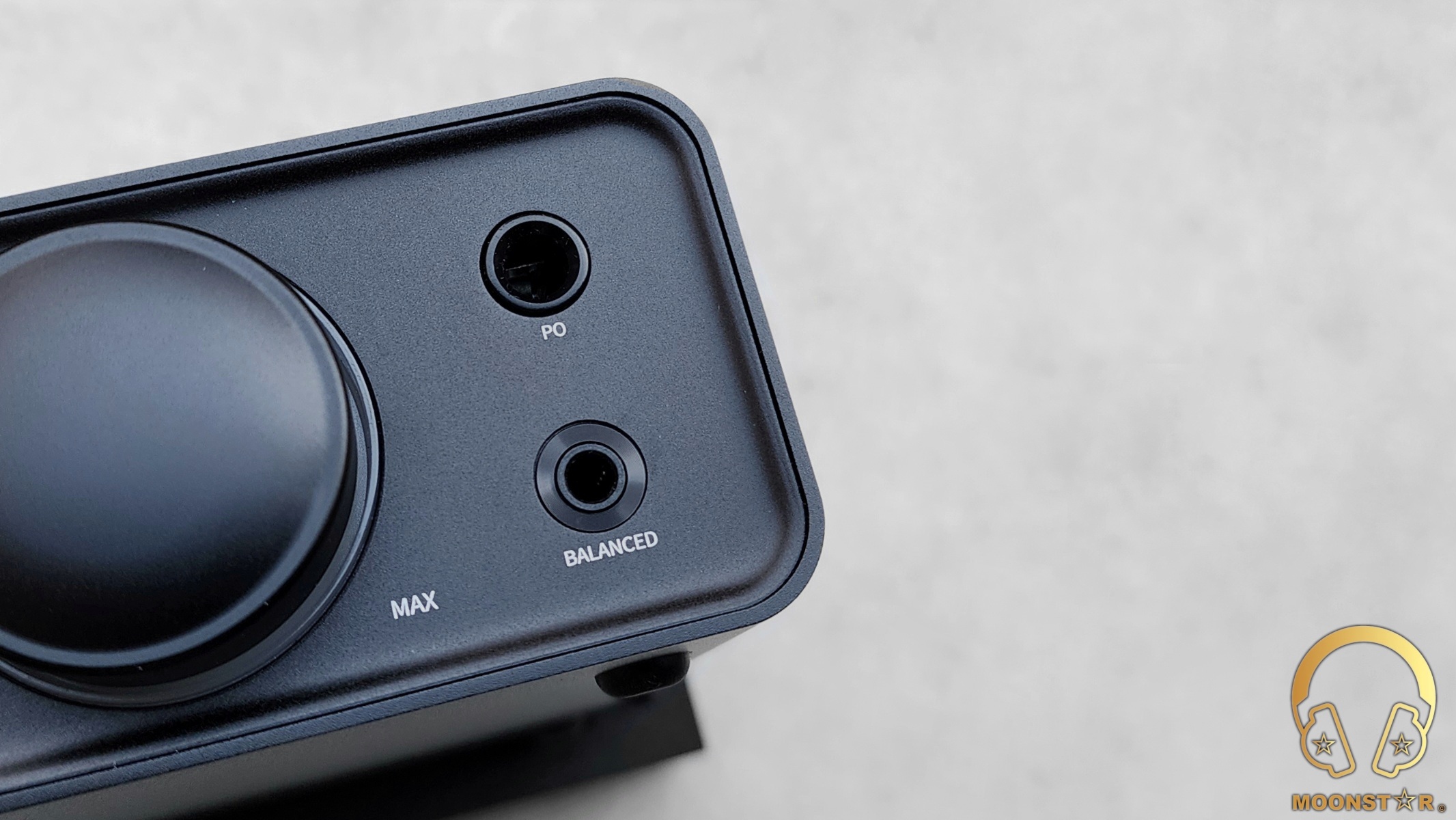
The center of the front panel is equipped with a volume wheel/potentiometer that sports a fancy looking RGB status indicator in form a ring that glows up in various colors depending of the codec and operating status of the device.
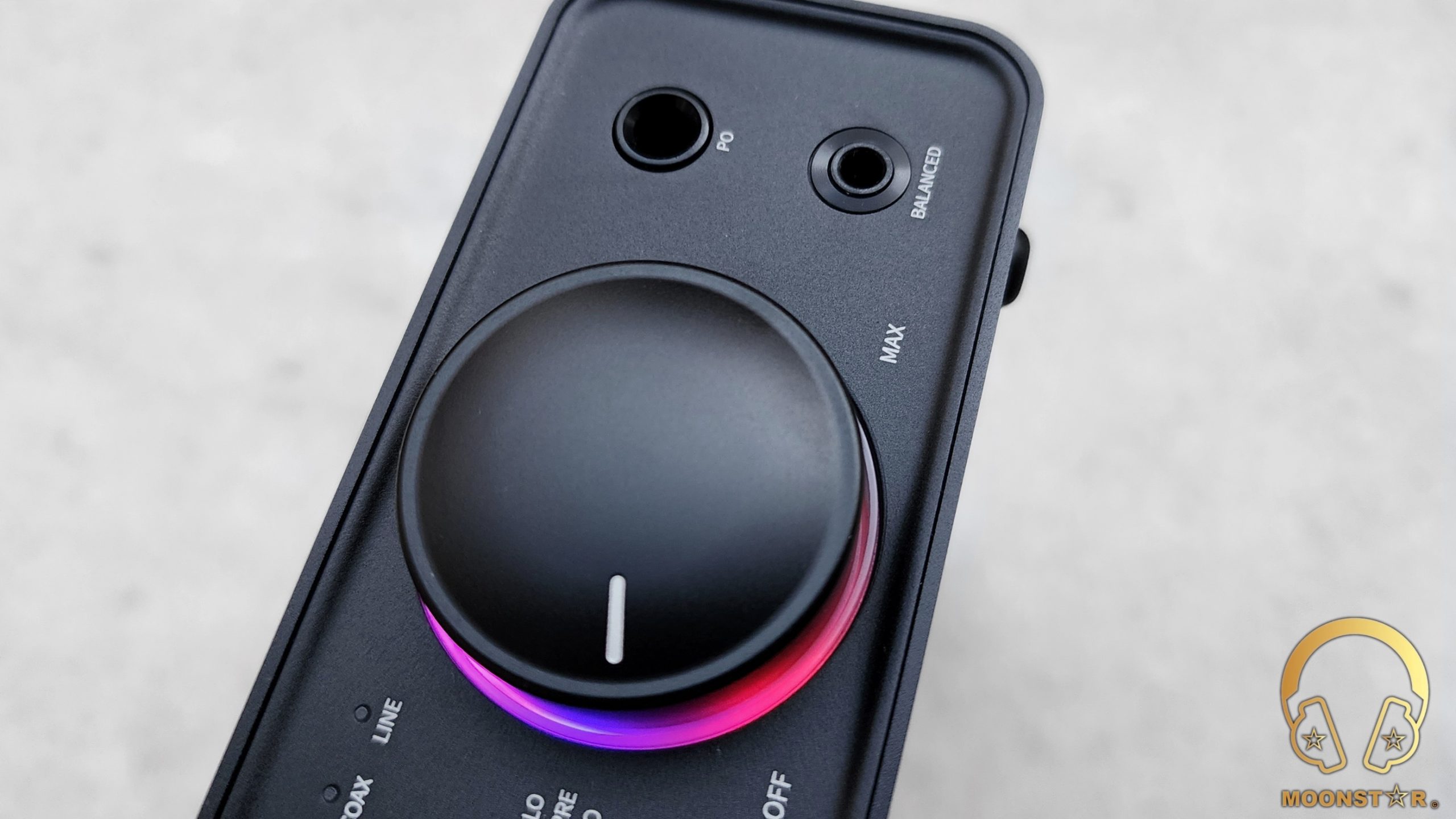
The left side of the front panel sports an input button and 4 LED indicators that give you information about the actual selected source. Moreover, here are two witches one for High/Low gain and one to select the output.
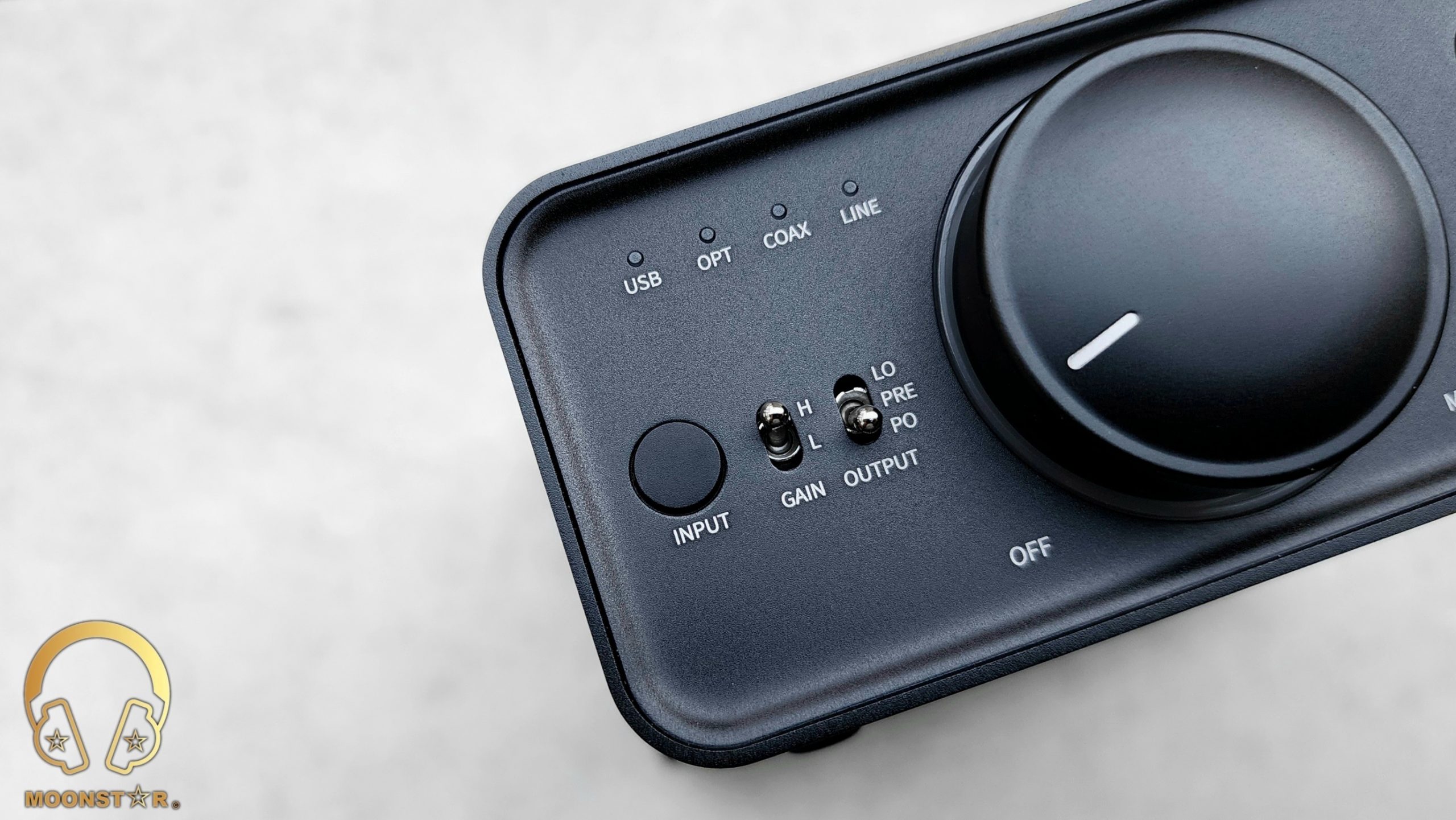
The rear panel of the K7 features a Single Ended Line-In, USB Type-B, Optical (Toslink), Coaxial Inputs and Single-Ended output interface. Here is also the power input of the device.
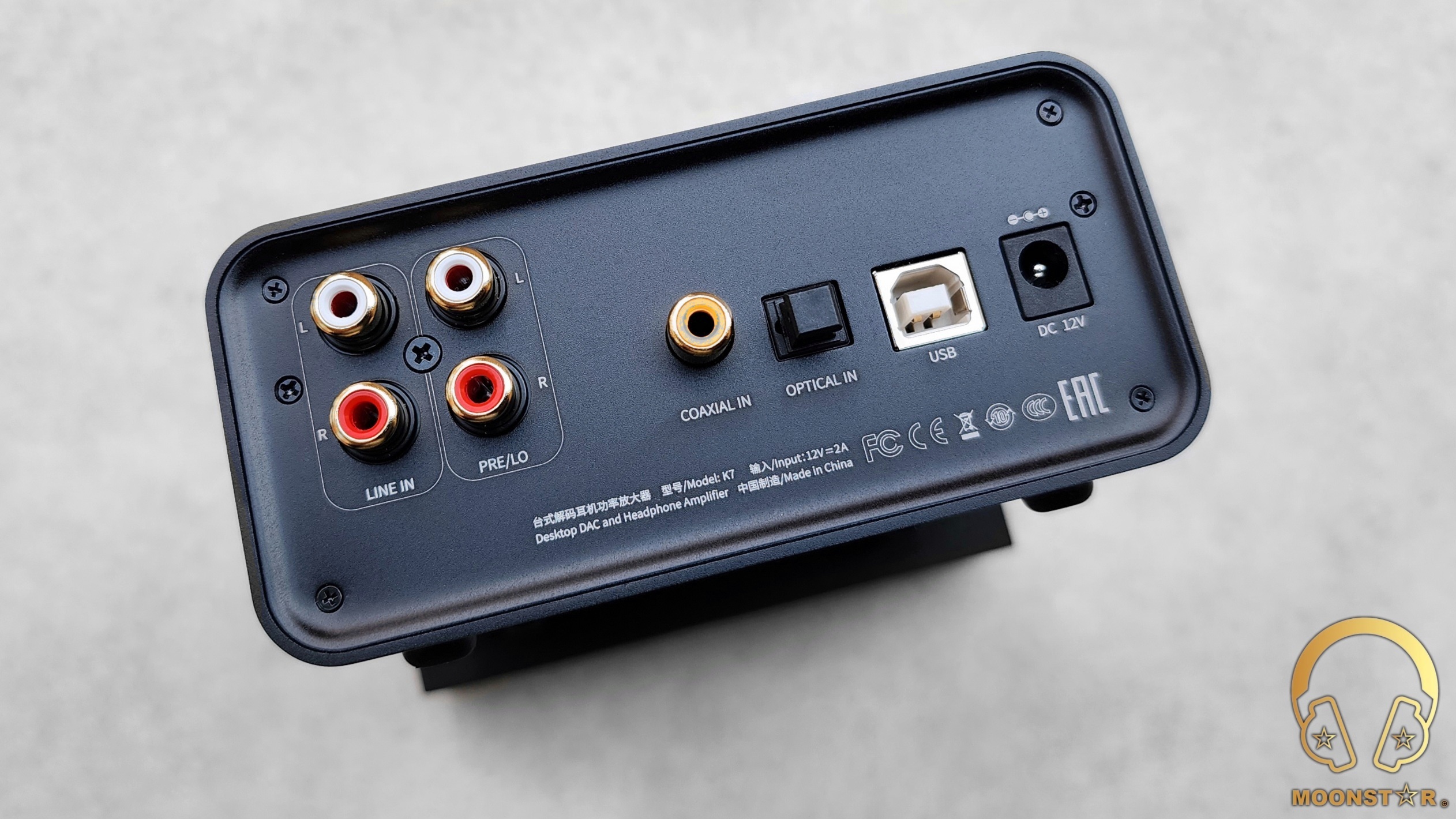
The overall build quality of the K7 meets my expectations from a devices at this price level same like other FiiO products.
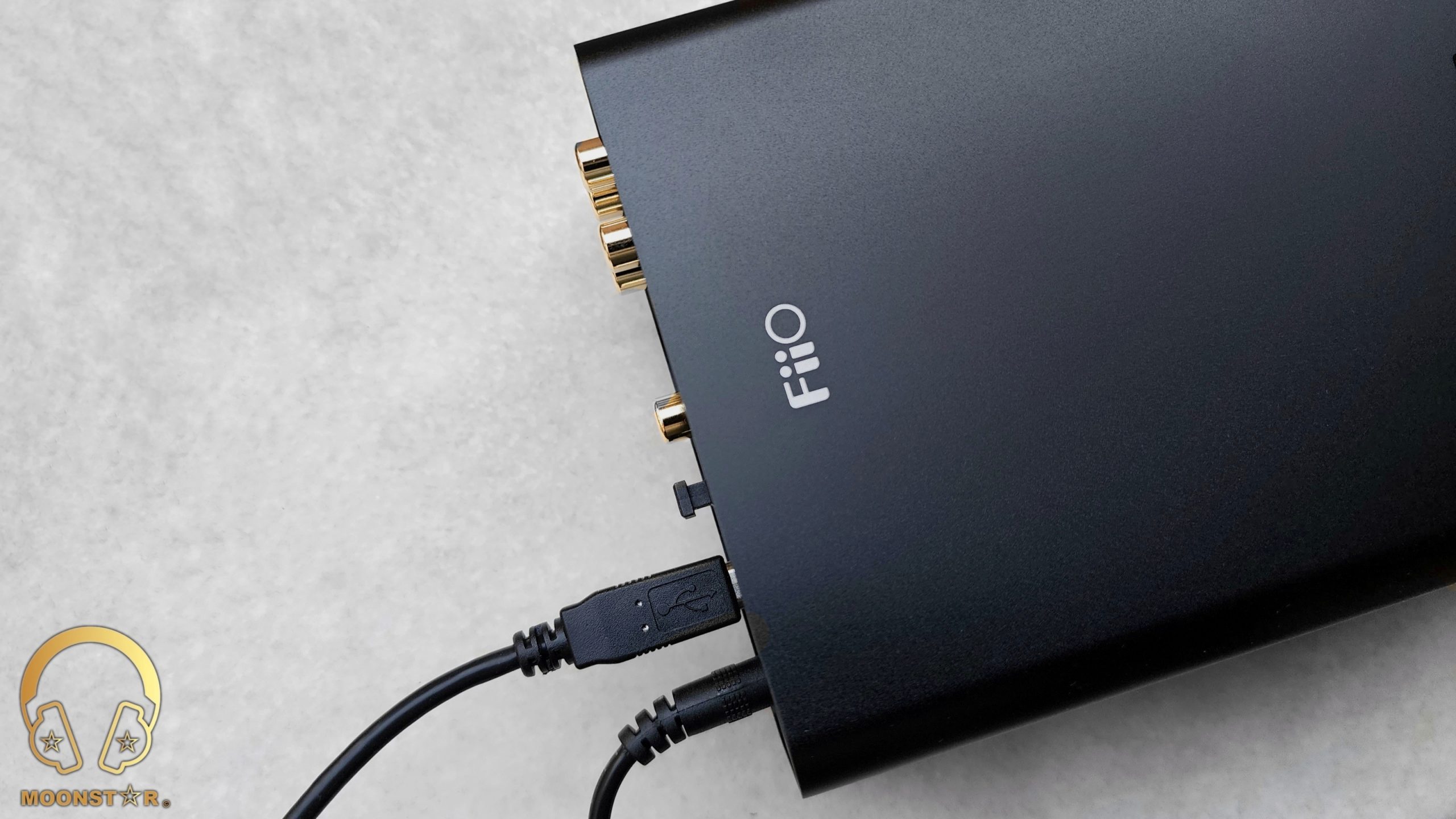
Specifications:
- Model : K7
- DAC : AK4493SEQ x2
- Decoder : XMOS XUF 208
- Amplifier : Dual THX AAA 788+
- Volume Chips : NJU72315+OP
- Outputs : 6.35mm Single-Ended + 4.4mm Balanced
- Inputs : USB, Optical, Coaxial, RCA
- 6.35mm SE Output : up to 1220mW @ 32Ω / 140mW @ 300Ω
- 4.4mm BAL Output : up to 2000mW @ 32Ω / 560mW @ 300Ω
- SNR : >120dB (A-weighted, UAC)
- Noise floor : PO<4.1uV
- THD+N : <0.0003% (1 kHz/32Ω/dbA)
- Output impedance : <1Ω
- Dimensions : 120 x 168 x 55mm
- Weight : 610g
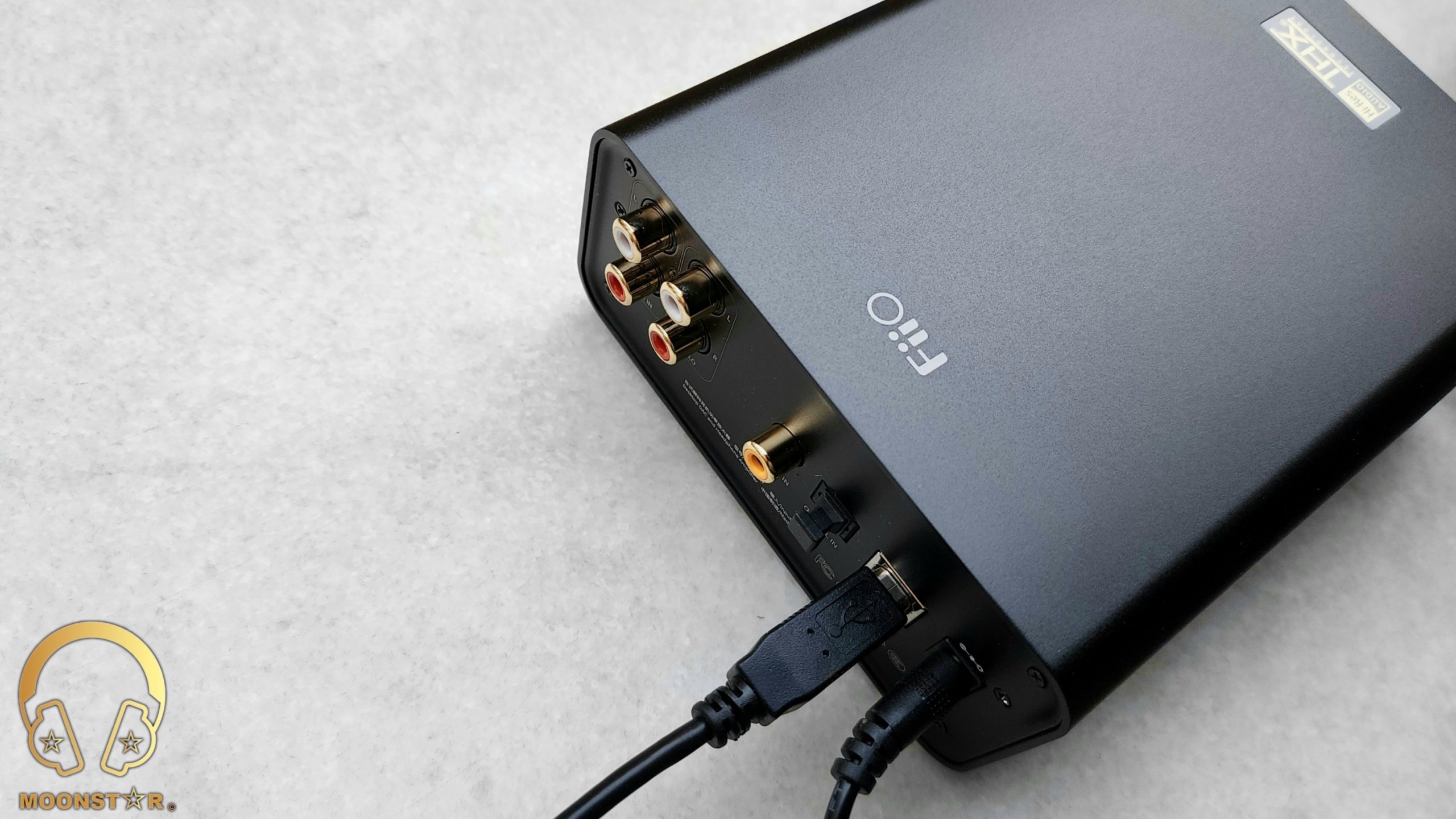
Hardware Features:
The FiiO K7 is a desktop DAC & Headphone Amplifier that features some interesting hardware specs such like a Dual AK4493SEQ DAC Chip setup, 2x THX AAA 788+ amplifiers, XMOS USB receiver and NJU72315+OP Volume chips.
AK4493SEQ DAC Chip:
The FiiO K7 is equipped with 2x AK4493SEQ DAC Chips of the company Ashai Kasei for its true balanced architecture. The AK4493SEQ is a high-performance 32-Bit Digital to Analog converter designed for audiophile-grade applications such as Digital Music players, Portable and Desktop type DAC’s and DAC/Amplifiers.
The AK4493SEQ inside the K7 offers a SNR (Signal to Noise Ratio) value of 120dB (A-weighted, UAC) and THD+N <0.0003% (1 kHz/32Ω/dbA).
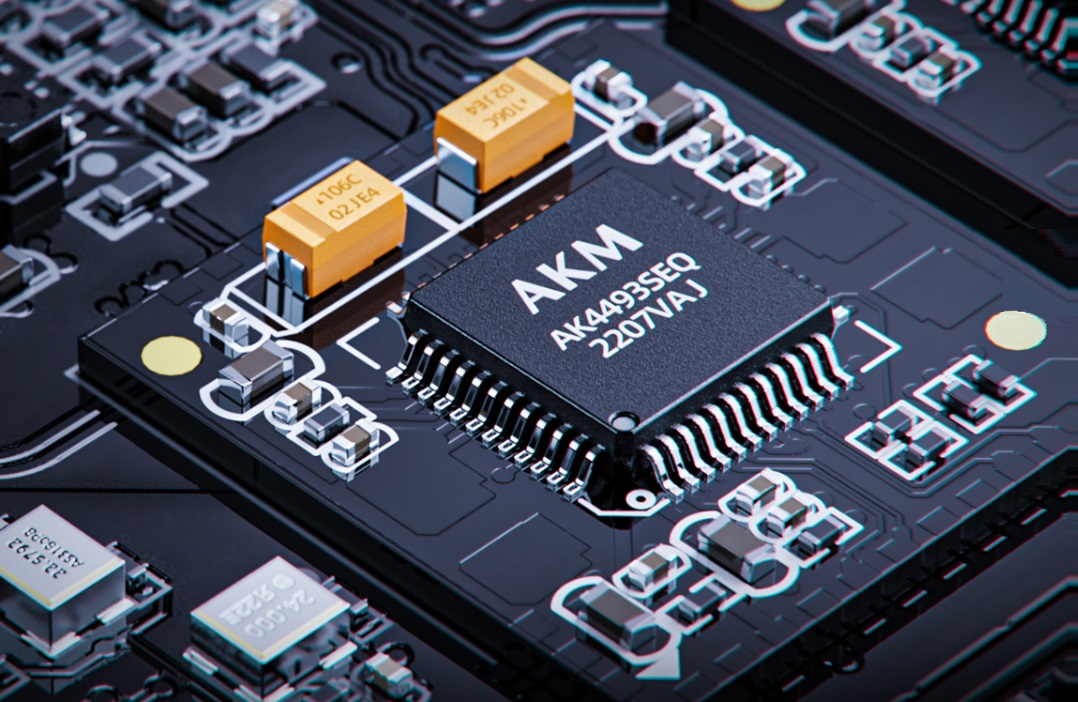
Analog Outputs & Amplification (2x THX AAA 788+):
The FiiO K7 is a quite powerful amplifier with a true balanced architecture, which means that each channel is driven independently. The K7 is equipped with both a 6.35mm Single-Ended and 4.4mm Balanced 3.5mm Single Ended (TRS) and 4.4mm Balanced (TRRRS) balanced outputs.
Another remarkable feature of the K7 is its THX AAA™ “Achromatic Audio Amplifier” design that was used to create a clean and powerful analog output. The K7 is able to create up to 1220mW per channel @ 32ohm over the 6.35mm Single-Ended output, while the 4.4mm Balanced out is even more powerful with up to 2000mW @ 32Ω and 560mW @ 300Ω, all with just 1% distortion, which is quite impressive.
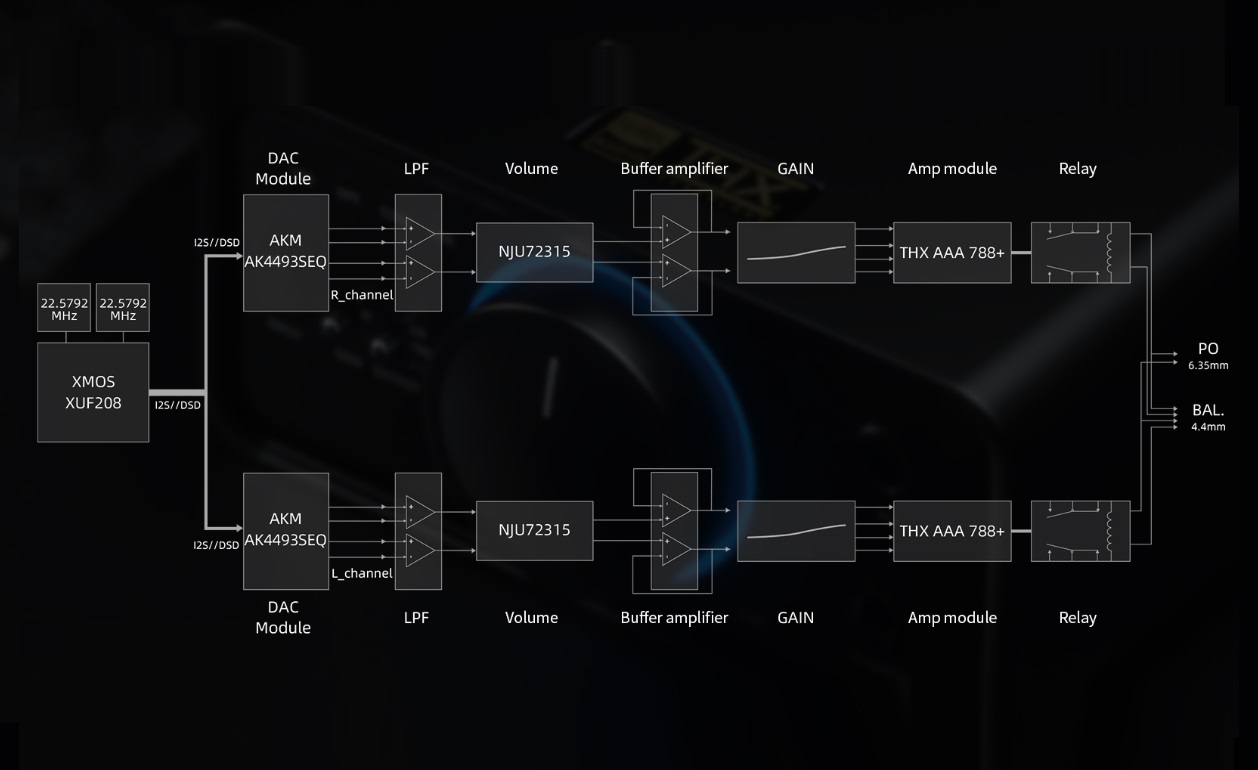
Here are some detailed Audio Parameters:
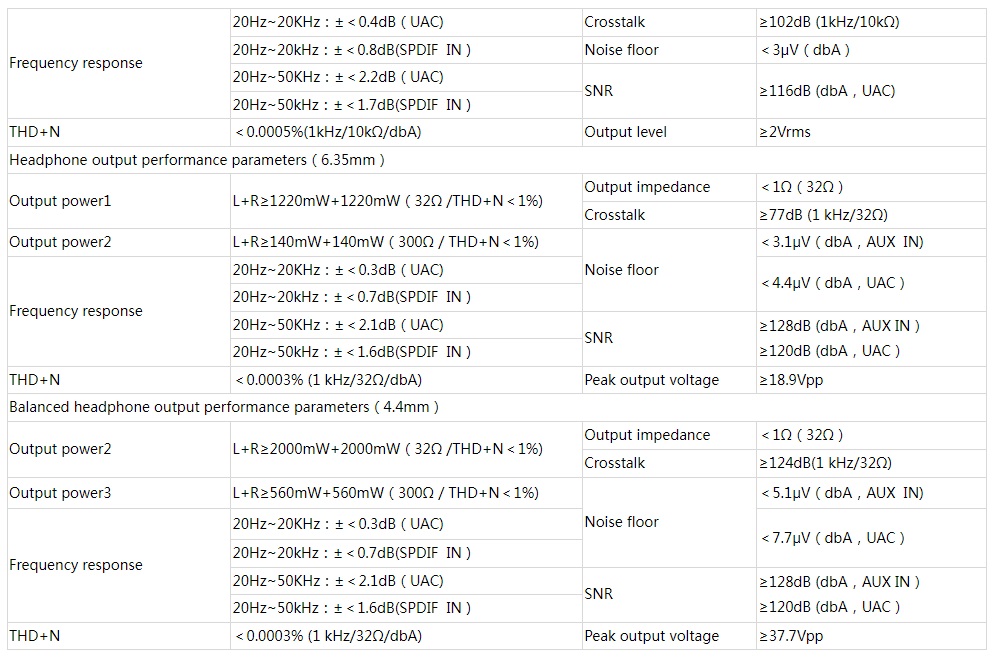
XMOS XU208 for Native DSD:
The FiiO New K7 is equipped with the XMOS XUF208 decoder chip that uses dual clock management in order to handle various music formats. XUF208 USB chip handles up to 384kHz-32bit PCM and Native DSD decoding up to DSD256 in USB DAC Mode.
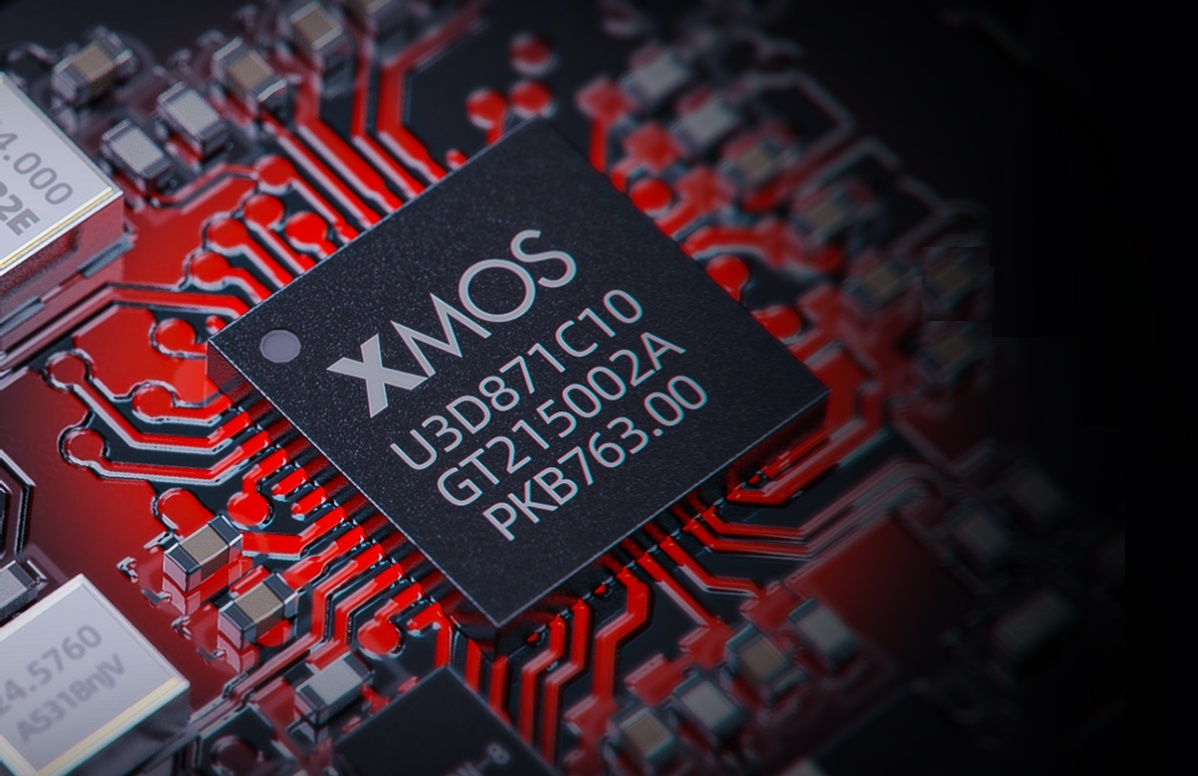
The RGB LED Indicator that surrounds the Potentiometer shows up the following sampling rates:
- Blue : 44.1KHz/48KHz
- Yellow :88.2/96/176.4/192/352.8/384KHz
- Green :DSD64/128/256

Low-Noise Power Supply:
The K7 features a power design consisting of multiple independent stages, with a voltage of each stage being regulated by low-noise LDO’s. Feeding this power design is an external 12V switching power supply.
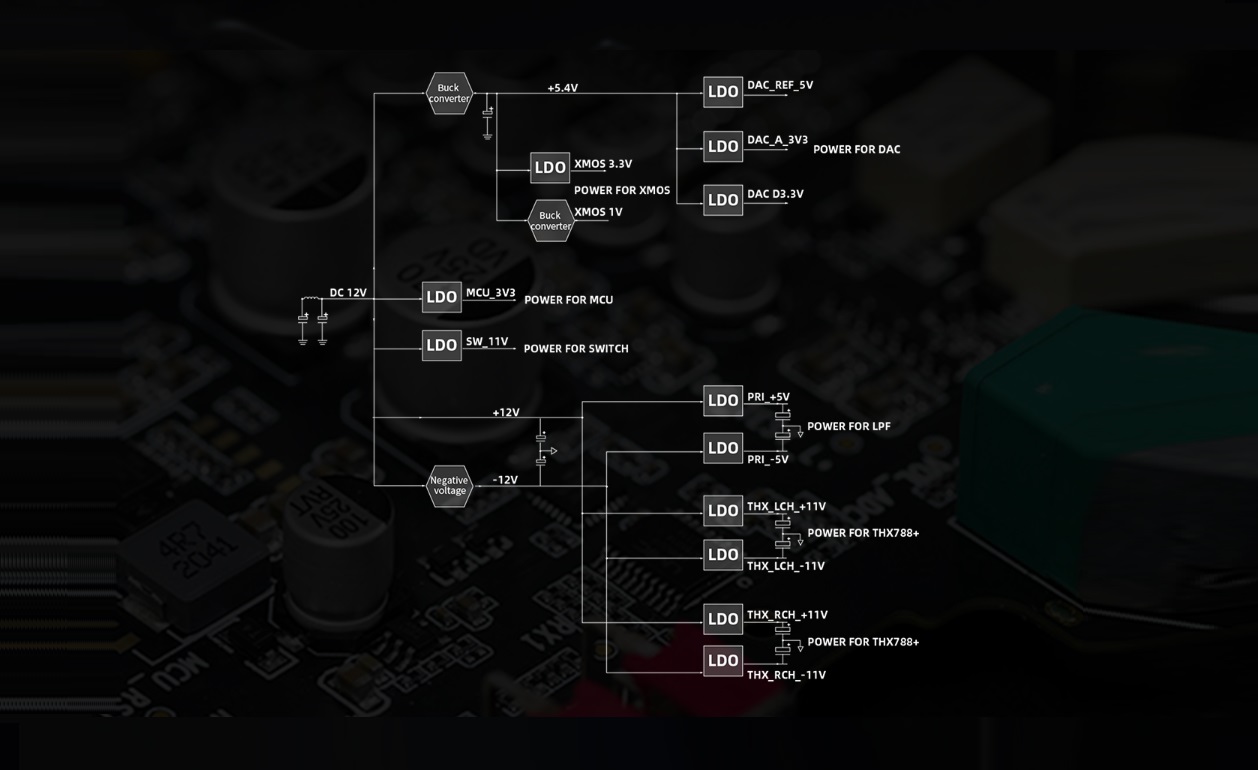
Equipment’s used for this review:
- DAC/Amplifier’s : FiiO K7 DAC & Headphone Amplifier
- Sources : ASUS TUF FX504GD
- IEM’s : FiiO FH9, FiiO FH7S, Meze Audio RAI Penta
- Headphones : HiFiMAN Sundara Closed-Back, HiFiMAN Edition XS
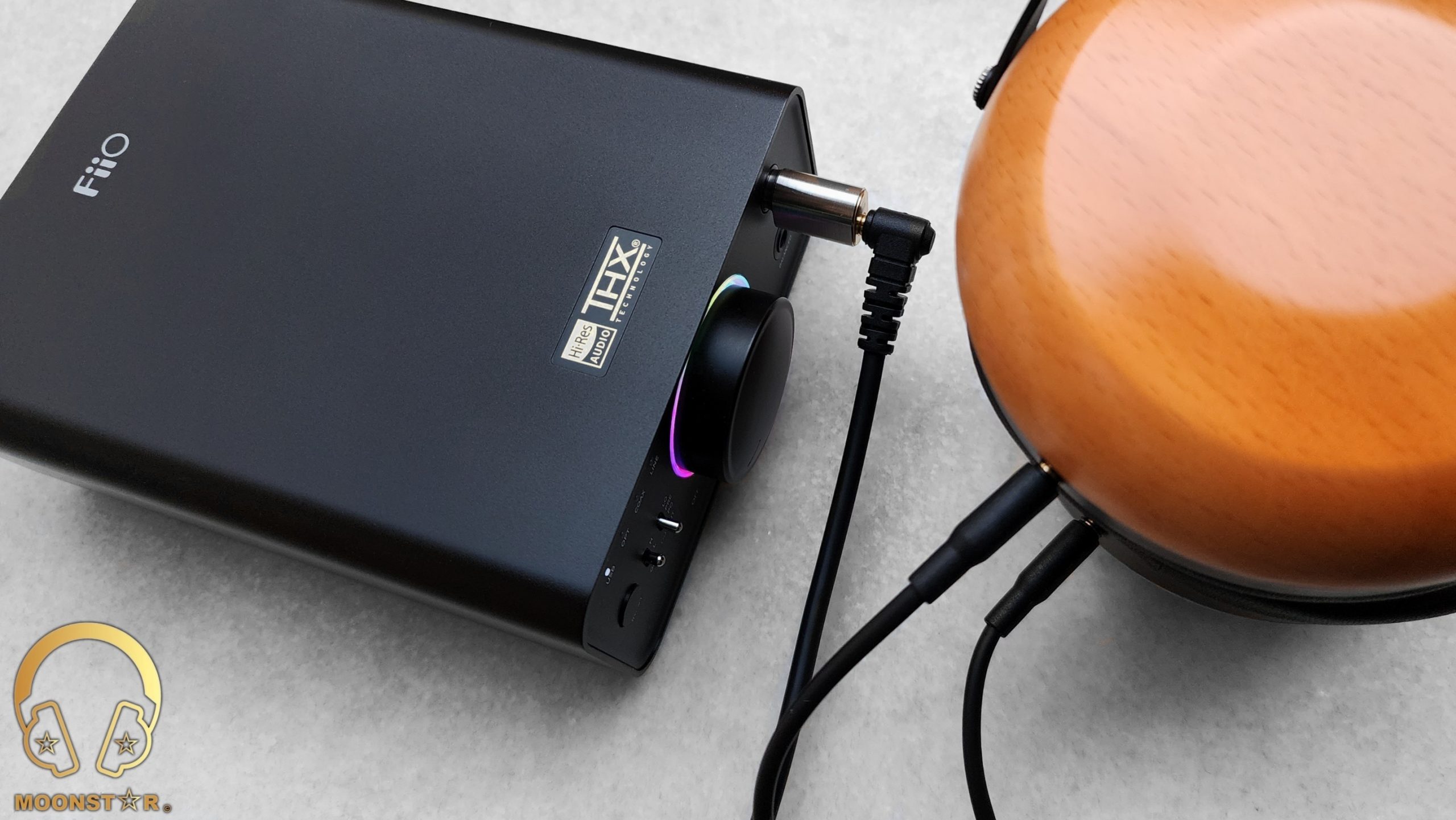
Albums & tracks used for this review:
- Adele – My Little Love (Dezzer HiFi)
- Randy Crawford – On Day I Will Fly Away (Flac 16bit/44.1kHz)
- Hayley Westenra – Odyssey Album (Dezzer HiFi)
- Dionne Warwick – Walk On By (Flac 16bit/44.1kHz)
- Sarah McLachlan – Angel (Flac 24bit/48kHz)
- Sertap Erener – Aşk (Flac 16bit/44.1kHz)
- Edith Piaf – Non Je Ne Regrette Rien (Flac 16bit/44.1kHz)
- Diana Krall – So Wonderful (DSF)
- Aretha Franklin – I Say A Little Payer (Flac 24bit/96kHz)
- Sonya Yoncheva – (Giuseppe Verdi) II Trovatore, ActI (Flac 24bit/96kHz)
- George Michael – Don’t Let the Sun Go Down on Me (Flac 24bit/192kHz)
- David Bowie – Heroes (Flac 24bit/192kHz)
- Elton John – Rocket Man ((Flac 24bit/96kHz)
- Barry White – Just The Way You Are (Flac 24bit/48kHz)
- Isaac Hayes – Walk On By (Flac 16bit/44.1kHz)
- Sting – Englishman in New York – (Flac 24bit/48kHz)
- Eric Clapton – Wonderful Tonight (Flac 24bit/96kHz)
- B. King – Riding With The King (Tidal Hi-Fi)
- Dave Gahan – Kingdom (Tidal Hi-Fi)
- U2 – Sunday Bloody Sunday (Flac 16bit/44.1kHz)
- Bro Safari, UFO! – Drama (Deezer HiFi)
- Armin Van Buuren – Vini Vici (Flac 16bit/44.1kHz)
- Daft Punk – Doin’ it Right (Flac 24bit/96kHz)
- Jo Blankenburg – Meraki (Spotify)
- Lorde – Royals (Flac 24bit/48kHz)
- Massive Attack – Angel (Flac 24bit/48kHz)
- Toutant – Rebirth (Deezer HiFi)
- Gogo Penguin – Raven (Flac 24bit/192kHz)
- Gogo Penguin – Murmuration (Flac 24bit/192kHz)
- Portishead – It Could Be Sweet (Spotify)
- Max Richter – On the Nature of Daylight (Flac 24bit/96kHz)
- Charly Antolini – Duwadjuwandadu (Flac 24bit/192kHz)
- Ferit Odman – Look, Stop & Listen (Flac 24bit/192kHz)
- Chopin – Nocturn No. 20 In C-Sharp Minor (Flac 16bit/44.1kHz)
- Fazıl Say – Nazım Oratoryosu (Live) (Flac 16bit/44.1kHz)
- Vivaldi – Le QuarttroStagioni “The Four Season” (Deezer HiFi)
- Otto Liebert & Luna Negra – The River (Flac 24bit/192kHz)
- Lunatic Soul – The Passage (Flac 16bit/44.1kHz)
- Deftones – My Own Summer (Shove it) (Flac 16bit/44.1kHz)
- Metallica – Sad but True (Flac 24bit/96kHz)
- Metallica – Master of Puppets (Flac 24bit/96kHz)
- Opeth – Windowpane (Flac 16bit/44.1kHz)
- Megadeth – Sweating Bullets (Tidal Hi-Fi)
- Rush’s – Leave That Thing Alone (Flac 16bit/44.1kHz)
- Slayer – Angel of Death (Spotify)
- Liquid Tension Experiment 2 – Acid Rain (Spotify)
- Yosi Horikawa – Bubbles (Spotify)
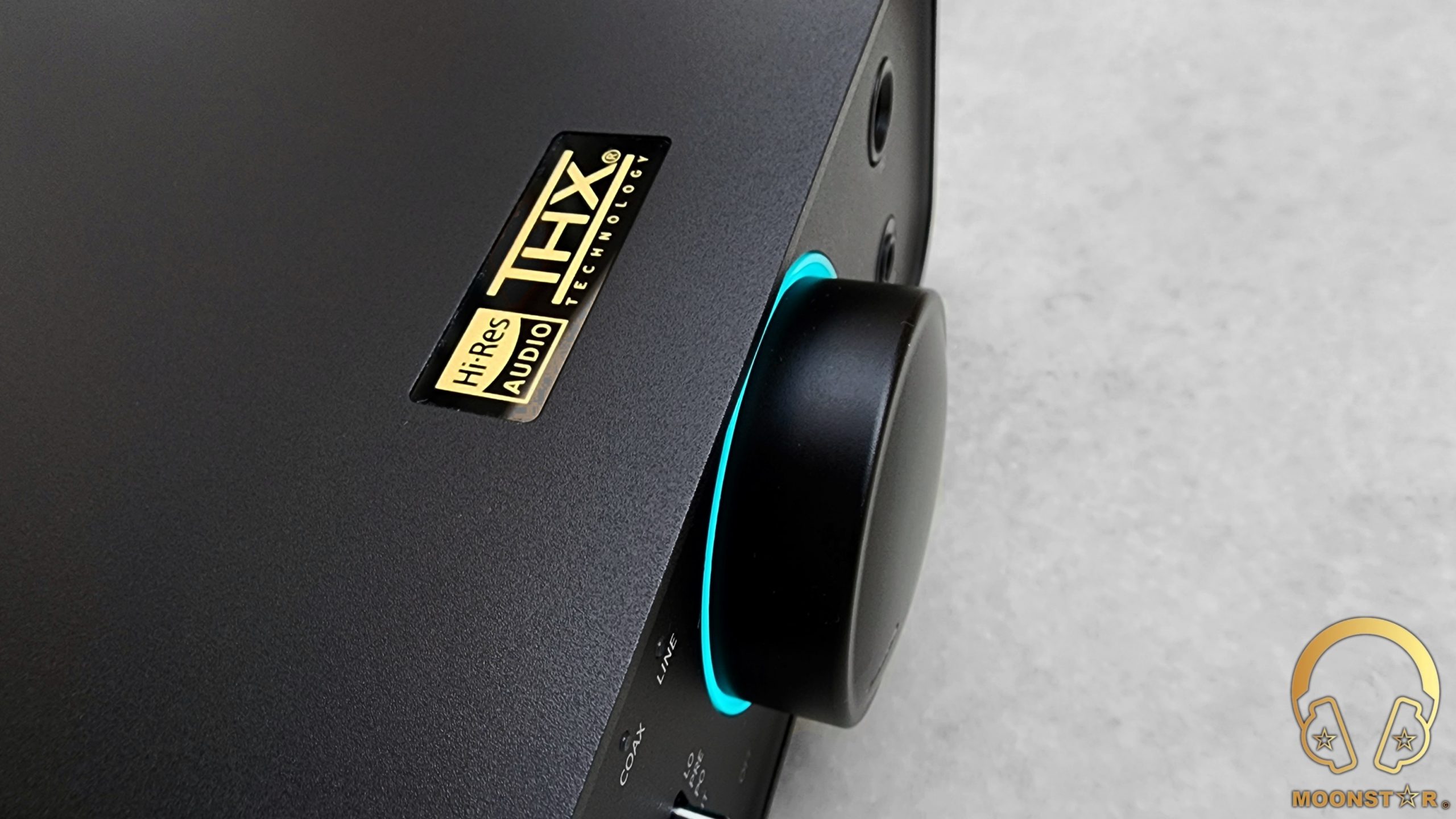
The Sound:
The FiiO K7 is a highly versatile and powerful DAC & Headphone AmplifierAmplifier solution that impressed me with its very clean and natural presentation, that shows just the right amount of coloration in order to create a pretty musical and to avoid a to sterile overall sound presentation. The K7 is a pretty detailed and natural sounding source with decent sense of technicality and dynamics for its price that works great with both power hungry full sized Headphones and pretty sensitive In-Ear Monitors.
This review has been written after a burn-in period of around 100 – 110 hours. My sound experience below are mainly based on my impressions over the 4.4mm Balanced output paired with In-Ear Monitors such like the FiiO FH9, FH7S and Headphones like the HiFiMAN Sundara and SIVGA Oriole.
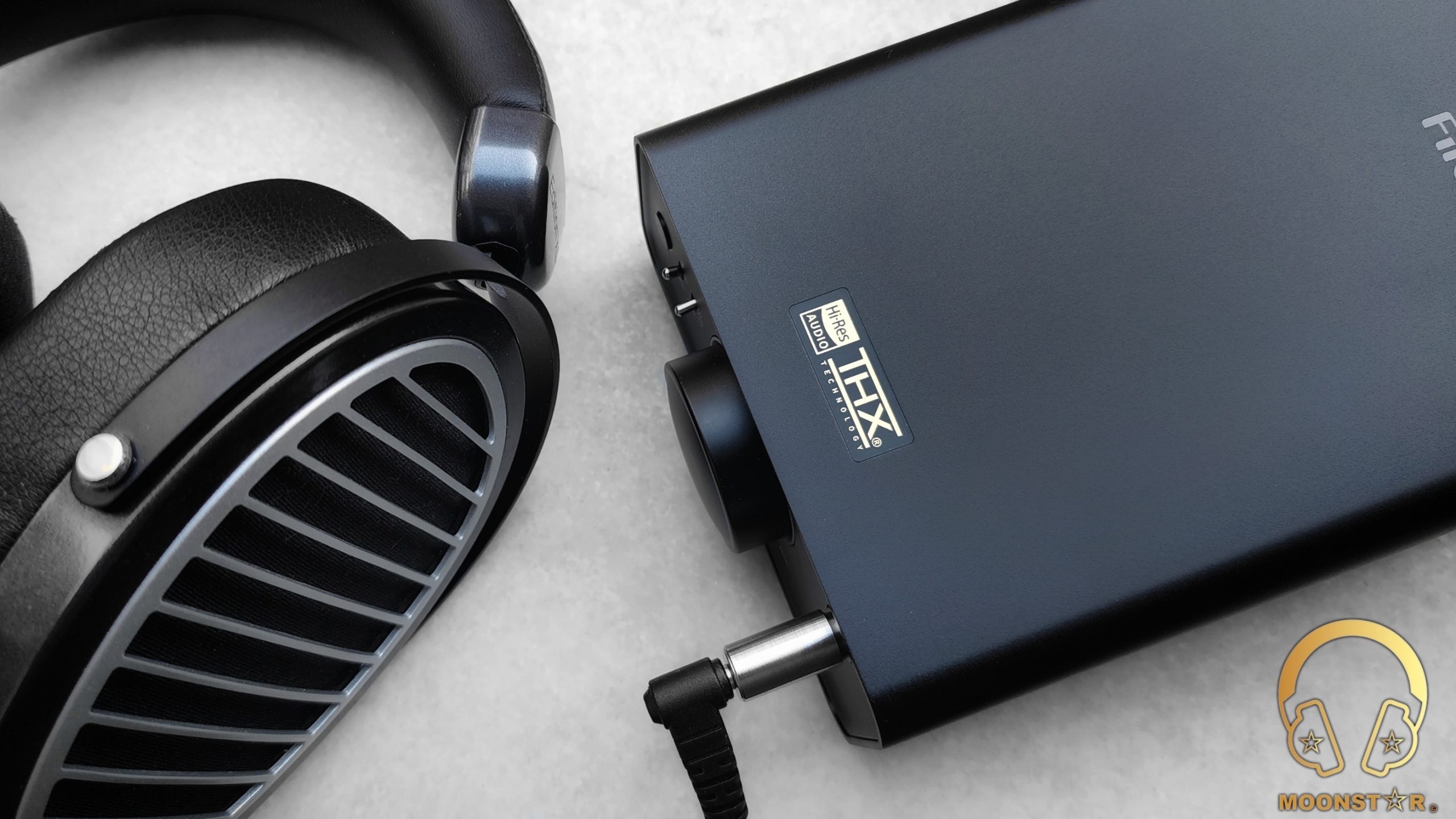
Bass:
The FiiO K7 offers a pretty natural, clean and nicely detailed overall bass response from the subbass up to the midbass region. It was also able to handle all headphones (HiFiMAN Sundara CB, HiFiMAN Edition XS) and IEM’s (FiiO FH9, FiiO FH7S, Meze Audio RAI Penta) in this area with decent sense of authority.
The subbass region of the K7 shows a decent grade of depth and authority with almost all IEM’s and Headphone I have listen to it. Some of my reference songs such like Lorde’s “Royals”, Massive Attack’s “Angle” or to Daft Punk “Doin’ it Right” have been produced with good level of rumble and extension.
The midbass region on the other hand is reproduced in a pretty natural and controlled manner along with a good sense of impact and intensity when I have listened to complex bass passages in songs like Gogo Penguin’s “Raven” or Charly Antolini’s “Duwadjuwandadu”. This is quite impressive for a device with such a reasonable pricing.
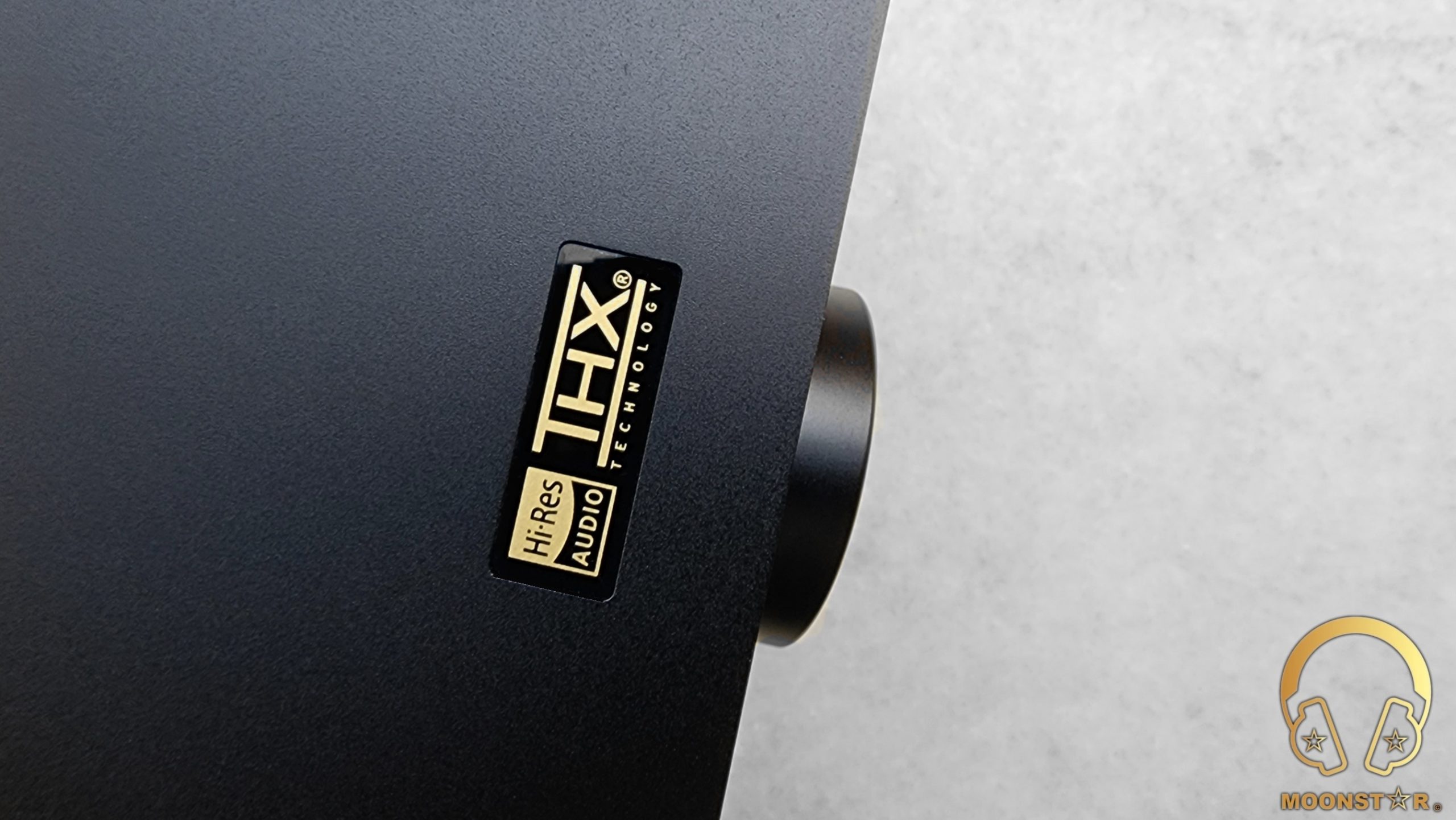
Midrange:
The midrange of the FiiO K7 stands out with it highly transparent and airy atmosphere when I listen to both vocals or to a wide variety of instruments, which shows again how capable this device is as a headphone/earphone DAC & Amplifier.
The sense of resolution from the lower up to the upper midrange area is excellent, especially with respect to the price of this device, which is also shown with an additional dynamism that comes with support from its pretty powerful THX AAA 788+ amplifier circuit.
I have listen to the K7 to a wide variety of instruments including violins, side flutes, cellos or pianos that have been reproduced with a decent level of resolution and naturalness, especially when paired with good In-Ear Monitors or headphones such like the FiiO FD7, Meze RAI Penta and HiFiMAN Edition XS, thanks to its quite airy and transparent midrange atmosphere.
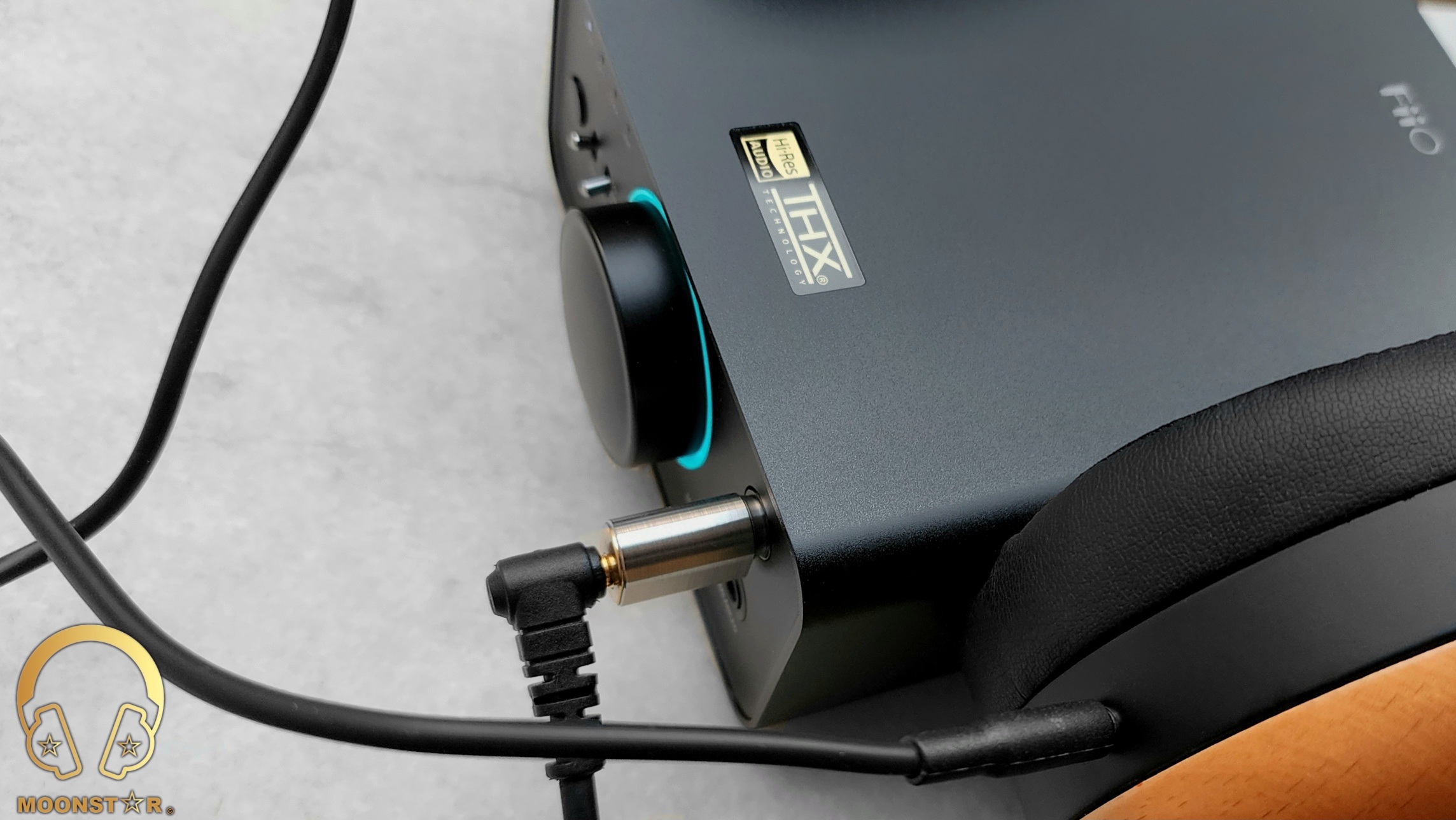
Treble:
What I really like about the treble presentation of the FiiO K7 is its pretty uncolored nature, which is also able to create a decent sense of clarity and sparkle with all IEM’s and Headphones I have paired the device. The grade of resolution and extension fulfills my expectation from a desktop DAC/Amplifier at this price level especially when I do listen to woodwinds, percussions and to soprano vocals.
Both the lower and the upper treble range are shown with a good level of balance. The lower treble area is shown with a decent grade of clarity and definition, while each individual instrument has been stand out pretty clearly. Instruments from hi-hats in metal music up to violins in classical music are reproduced with good level of presence and extension.
The upper treble area of the FiiO K7 creates a fairly open and airy atmosphere with good sense of brightness that is needed for vocals and for instruments such like cymbals, violins or clarinets without to show any remarkable hissing. The general extension and resolution of this area is again, excellent for a DAC/Amplifier at this level.

Soundstage & Imaging:
The FiiO K7 has a general soundstage presentation that is spacious and airy, which creates decent conditions for a pretty precise separation and placement of instruments and vocals. The soundstage is both fairly wide and deep, while the height of the stage is on a sufficient level.
Conclusion:
The K7 is another solid product from FiiO that impressed me with its versatility in terms of hardware features, compatibility and overall sound performance that pairs pretty well with both sensitive In-Ear Monitors and power hungry Planar Headphones. Moreover, it offers a clean, powerful and quite detailed listening experience that surprised me very well with respect to its reasonable price. The result is a DAC & Amplifier with a pretty small form factor that I can Highly Recommend!
Pros & Cons:
- + Natural, Clean & Dynamic Presentation
- + Pairs pretty well with both Sensitive IEM’s & Power Hungry Headphones
- + Hardware Features (THX AAA-788+ Amplifier Section, AK4493SEQ, etc.)
- + Wide variety of Input & Output Options
- + Size, Build Quality & RGB Indicator
- + Excellent Value for your Money
- – No MQA Decoding
- – Wireless Connectivity options (Wi-Fi and/or Bluetooth) would be welcome
Thank you for the Read!


